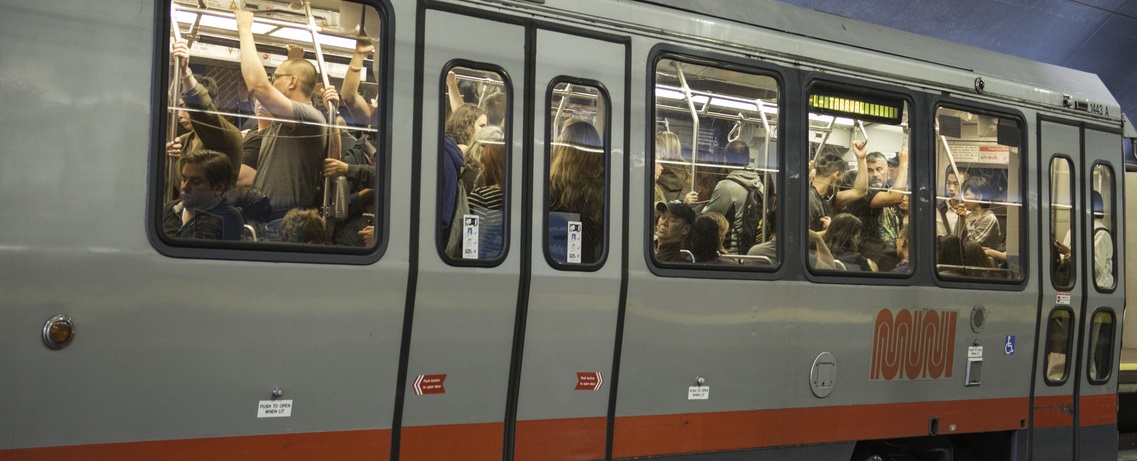
Get all the way across the city from SF State to the Embarcadero in a straight shot underground?
Improve the capacity of four different Muni Metro lines with one project?
It’s all possible through a visionary, long-term plan introduced by the SFMTA that would move the M Line underground from West Portal to Parkmerced. Undergrounding that portion would make the M Line a subway for the entire length of the route.
Doing so would allow the line to run longer trains, creating a high-capacity subway transit spine across the whole city that would provide faster, more efficient cross-town travel and unlock the ability to use the existing Muni subway to its full capacity.
That’s the idea behind the SFMTA “Full Subway” Plan, part of the agency’s soon-to-be renamed 19th Avenue/M Ocean View Project. The ambitious, underground option was designed as an alternative to an all-surface M Line re-alignment plan recommended in the 2011 Parkmerced Development Agreement, the deal for a major housing development at the terminus of the line. As part of that agreement, the SFMTA was also allowed to develop an alternate plan. That plan would not only benefit the fast-growing southwest corner of the city where several major developments are in the works. It would help move everyone faster throughout Muni's subway system.
Finishing what BART started in the 1970s
Muni Metro was the name given to Muni’s light-rail vehicle operation in the 1970s after BART built the existing Muni subway. The new Muni Metro tied Muni’s historic streetcar routes in western San Francisco to a new rapid transit tunnel built under Market Street.
New stations will be designed for the new subway portion to serve four-car trains, doubling M Line capacity as well as adding substantially to the Market Street subway’s capacity. More capacity is already needed and major population growth near Muni Metro is planned and underway — including new high-rise housing projects near the intersections of Market and Van Ness, as well as recent job growth in Civic Center, Mid-Market, and SoMa. Redevelopment efforts are also planned and underway at Parkmerced and San Francisco State, and under discussion at Stonestown Galleria.
System-wide benefits
While the project is a major investment in southwest San Francisco, the benefits will be felt all over the system, with more train cars to pick up passengers at busy stops like Castro, Church and Civic Center. The proposed project also dovetails with Muni’s Rail Capacity Strategy, an overarching plan to boost rail capacity to allow for the city’s future growth. The M Line project is one of four long-term projects deemed Tier 1 priority for implementation.
Improving safety
Another major benefit of this plan is the safety improvements to 19th Avenue, which is part of the city’s High-Injury Network, the 12 percent of city streets where more than 70 percent of severe and fatal collisions occur. The vacated rail median would be re-purposed for a protected bike path, wider sidewalks and a landscaped median, decreasing the distance across the street by more than 30 percent. Transit riders who must currently cross busy 19th Avenue to catch trains running down the middle of the street would instead board from subway station entrances on the sidewalk, avoiding traffic entirely, which will help the city reach its Vision Zero goal of ending all traffic fatalities.
Stakeholder support
While the Full Subway alternative was met with strong support by community members during four recent outreach meetings, there were two common areas of the concern: Some in the Ocean View neighborhood raised issues with the prospect of introducing a new transfer for trips they are currently able to make on the M Line. Also, many were skeptical about the high cost — $2.5 billion to $3 billion in 2016 dollars.
The initial Parkmerced surface project included $70 million for construction. This can be leveraged for the larger subway project, which staff hope to fund by seeking an FTA Core Capacity federal grant, matched by state, regional, local and private funding. This creates a strong local match for a project that will have wide-ranging benefits.
But it won’t be a quick fix, with a projected 10 to 15 years for completion assuming full funding is identified. And before that, the agency must tackle the project’s environmental review, which is expected to begin next year.
The project is also looking for a simpler, less ambiguous name, one that reflects the benefits that will be felt throughout the rail system should the Full Subway plan come to fruition. Muni Underground, Subway Expansion Project, Muni Subway Expansion and Muni Metro Modernization are a few of the recent suggestions. If you have some naming ideas, please add them to the comments section.
For project materials including conceptual drawings, visit www.sfmta.com/19thave.
The SFMTA Full Subway alternative.